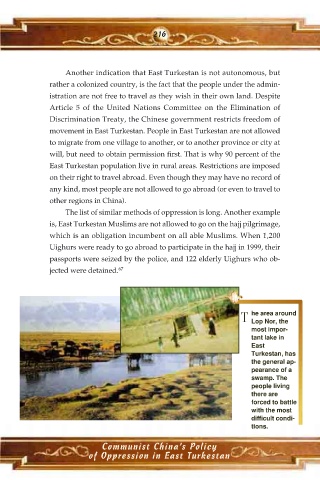Page 220 - Communist Chinas Policy of Oppression in East Turkestan
P. 220
216
Another indication that East Turkestan is not autonomous, but
rather a colonized country, is the fact that the people under the admin-
istration are not free to travel as they wish in their own land. Despite
Article 5 of the United Nations Committee on the Elimination of
Discrimination Treaty, the Chinese government restricts freedom of
movement in East Turkestan. People in East Turkestan are not allowed
to migrate from one village to another, or to another province or city at
will, but need to obtain permission first. That is why 90 percent of the
East Turkestan population live in rural areas. Restrictions are imposed
on their right to travel abroad. Even though they may have no record of
any kind, most people are not allowed to go abroad (or even to travel to
other regions in China).
The list of similar methods of oppression is long. Another example
is, East Turkestan Muslims are not allowed to go on the hajj pilgrimage,
which is an obligation incumbent on all able Muslims. When 1,200
Uighurs were ready to go abroad to participate in the hajj in 1999, their
passports were seized by the police, and 122 elderly Uighurs who ob-
jected were detained. 67
T he area around
Lop Nor, the
most impor-
tant lake in
East
Turkestan, has
the general ap-
pearance of a
swamp. The
people living
there are
forced to battle
with the most
difficult condi-
tions.
Communist China’s Policy
of Oppression in East Turkestan

